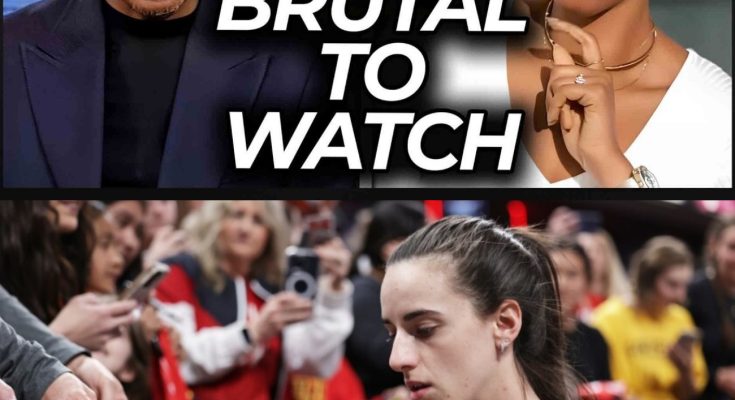Caitlin Clark, the WNBA, and the Golden Goose Dilemma: Instigation, Resentment, and a League at a Crossroads
For a league that’s spent nearly three decades in the cultural periphery, the WNBA has finally found itself center stage—and it’s not just because of improved play or steady progress. The seismic attention is almost entirely due to one rookie: Caitlin Clark. Yet the very phenomenon that made the league a trending topic has also exposed its deepest rifts—resentment, mishandled opportunities, and the perils of failing to protect the “golden goose.”

Instigation and Comeuppance: The Clark Narrative
There’s a certain narrative gaining steam: Some believe Clark has brought much of the targeting on herself. She’s fiercely competitive. She talks trash, waves off opponents, throws elbows, and, yes, sometimes antagonizes rivals in ways that, in men’s basketball, are considered par for the course. As Stephen A. Smith recently said, “Caitlin Clark does this. She talks. She waves. She antagonizes.” According to Smith, resentment toward Clark isn’t just about her popularity or marketability—it’s also a reaction to her on-court persona.
The controversy harks back to college, especially the infamous Caitlin Clark vs. Angel Reese incident. Clark’s trash talk—like her now-iconic hand-wave—drew the ire of other teams. When she finally lost, as in the LSU–Iowa showdown, the response from opponents was, as Smith noted, “Yeah, it’s your turn.” The implication: Clark can dish it, and sometimes, she has to take it.
But, as video evidence and national dialogue pile up, so do the bruises. Clark isn’t just playing against the league’s best; she’s enduring levels of physicality bordering on hostile—elbows, body checks, eye pokes, flagrant fouls, and nightly targeting. While some resistance is simply part of Clark’s ascension or her “comeuppance,” much of it crosses the line from competitiveness to outright mistreatment.
Resentment Runs Deeper Than Basketball
But personality isn’t the only factor. Let’s address the elephant in the room: Caitlin Clark doesn’t look like many of the league’s established stars. To ignore that would be naïve. She is white and straight in a league with a high proportion of Black and/or openly LGBTQ athletes. As one commentator delicately put it, “She looks different than most people who have been in the league before.”
It creates a parallel with the Tiger Woods era in golf or Venus and Serena Williams in tennis—only inverted. Woods and the Williams sisters entered majority-white spaces and, despite adversity, produced windfalls for leagues that had largely ignored them. Clark is now a minority in her own way within the cultural context of the WNBA, and her presence (and the fans she attracts) have both boosted the league and complicated its internal dynamics.
The Business Conundrum: Golden Goose or Missed Opportunity?
Here’s where things get truly tricky. For most of its existence, the WNBA has struggled financially—never turning a profit, fighting irrelevance, and saddled with a low average salary (about $75,000 a year). Clark’s arrival changed the math. Suddenly, games sell out, merch flies off the shelves, and TV ratings soar. For many players, especially those earning a fraction of their NBA counterparts, endorsement potential and a larger revenue pie are a lifeline.
But, as the transcript notes, the league’s failure to fully seize this moment is glaring. She doesn’t even have her own sneaker yet. The economic model is clunky: fines are little more than parking tickets; most players aren’t paid enough to take the financial risks that would come with an “everybody eats” ethos adopted by tennis or golf. Instead of capitalizing collectively—by riding the Clark wave and expanding the tent—the WNBA looks, to many casual fans, confused, reluctant, and even hostile to their best chance at mainstream success.

The Physical Toll and the Leadership Failure
A deeper fear stalks the league: What if Clark gets seriously hurt? Women’s basketball is notoriously susceptible to knee injuries (ACL tears occur at much higher rates than in the men’s game), and Clark recently missed time with a quad strain. If she were to suffer a significant injury—be it from normal play or this pattern of “roughing up”—the entire league’s resurgence could evaporate almost overnight.
The consensus among business and sports commentators is simple: Make hay while the sun shines. Protect your star, elevate your product, and, crucially, foster an environment where EVERY player wants to share the spotlight, because everyone wins when the pie grows. Instead, the current dynamic feels regressive; the league seems unprepared to maximize Clark’s positive impact, or to diffuse the jealousy and resentment swirling around her.
A Failure of Leadership and Vision
Both men’s and women’s tennis, along with golf, once faced similar crossroads. Instead of infighting, icons like Woods, Federer, Serena Williams, and Sharapova understood the “rising tide lifts all boats” principle and drove up purses, endorsements, and global attention. The WNBA, on the other hand, risks squandering this moment.
Why? It’s not just about money. It’s about old wounds—identity, representation, perceived favoritism, and a suspicion, voiced by some league veterans, that all attention is being poured onto a star who hasn’t yet “paid her dues,” both in a physical and existential sense.
A Fork in the Road for the WNBA
The entire WNBA project stands at a crossroads. Does it embrace the “Clark Effect,” take the hit for any temporary backlash, and ride the wave to higher salaries and broader attention for all? Or does it allow petty resentments, fragile egos, and institutional inertia to torpedo the single greatest opportunity the sport has had since its beginning?
Caitlin Clark may have instigated some of the animosity with her brashness, but the onus now falls on league leadership. The players, owners, and especially the commissioner must promote a culture that protects stars—ALL stars—while recognizing the game is bigger than any one athlete, even if, for this moment, one woman is undeniably the engine.
Full Video:
Conclusion: Don’t Break the Golden Goose
The future of the WNBA is dazzlingly bright—if it has the wisdom and courage to seize the moment. That means protecting Caitlin Clark, amplifying everyone she lifts up, and making sure that future stars, no matter what they look or act like, are celebrated rather than resented. The league’s growth depends on recognizing opportunity, not undermining it.
If the WNBA learns this lesson, Clark’s “instigation” will have sparked more than a culture war—it will have kicked off a new era of prosperity for women’s sports.

